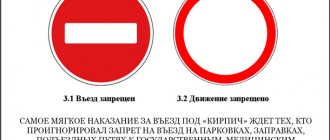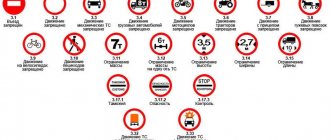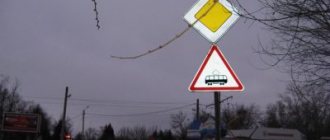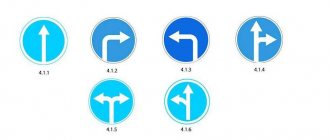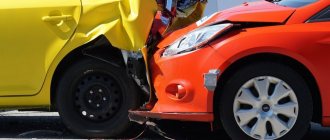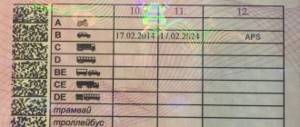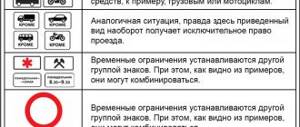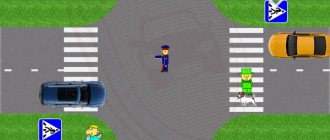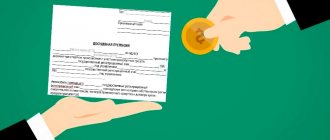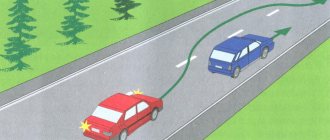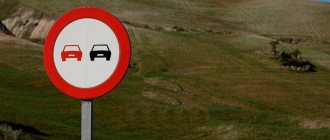Features of the fine for driving under a “brick” in 2021
What does the sign look like? “No Entry” is a red circle with a white rectangle. Because of this rectangle, the sign was nicknamed “brick”.
This is sign 3.1 in the traffic rules. Drivers simply call it "brick"
Sometimes the sign is supplemented with signs:
- validity time - on certain days or hours, for example on weekdays from 8 a.m. to 5 p.m. This means that driving under the sign is prohibited at the specified time.
- with a down arrow - it indicates a lane in which you cannot drive.
The sign means that the sign is valid on weekends from 8:00 to 17:30
The arrow indicates that the sign is valid in a specific lane
Where on the road are signs placed? There is a sign like this at the entrance:
- into the lane with oncoming traffic;
- to a lane for fixed-route transport;
- to the loading and unloading zone of large enterprises;
- in the residential sector next to playgrounds and pedestrian areas.
Who records the violation? This could be a traffic police inspector or a traffic camera. The sign may be accompanied by a “video recording” sign. This means that driving under the sign is recorded by a camera and the driver automatically receives a fine.
If you noticed the sign late and think that you might have received a fine for driving under a “brick” on camera, check it out on “Traffic Police Fines”.
What categories of vehicles can drive under a brick?
There are a number of exceptions in which cars can drive despite a prohibitory sign. This requirement does not apply to certain categories of vehicles. These include:
- Route and passenger vehicles;
- Cars that are used to transport disabled people;
- Vehicles used in private enterprises;
- Car owners who are residents of the area under the prohibited sign;
- Special equipment and trucks that unload materials during construction, repair or installation work;
- Emergency vehicles and mail.
Driving on a section of road that is marked with a prohibitory sign is considered an offence. This is subject to administrative liability, a fine, and in some situations, deprivation of rights. To prevent punishment, drivers should know when driving under a brick is not prohibited.
What types of fines are provided?
| Violation | Fine | Article of the Administrative Code |
| Driving into oncoming traffic on a one-way road | 5000 rub. or deprivation of rights for up to six months | 12.16 |
| Repeated trip to oncoming traffic in a year | 5000 rub. - from the camera, extra for a year - from the inspector | 12.16 |
| Entry into a closed area | 500 rub. | 12.16 |
| Entrance to the yard | 500 rub. | 12.16 |
| Leaving or stopping in a bus lane | 3000 rub. in Moscow and St. Petersburg, 1500 in the regions | 12.17 |
Whether the driver’s license will be deprived or just fined depends on the court’s decision, and in case of a repeated violation, on the method of recording. When a violation is recorded by a camera, the rights cannot be deprived by law.
Alexander Torvard, auto lawyer The camera only sees the license plate number, but it does not distinguish who is driving. It's not a fact that it's the driver. For example, this could be a person without a license to whom the owner gave the car for a ride. If the driver is caught by an inspector, he sees the whole picture: the license plate number of the car and the real culprit. There is no need to prove that the owner of the car was driving.
When is only a fine imposed?
But the “brick” is not only installed in front of a one-way road. So, it can hang for the following purposes:
- to designate separate entry and exit zones at gas stations, parking lots and other adjacent areas: accordingly, at the end of the entry and exit there is a “brick”, turned in the other direction to prohibit entry from that very other side,
- to indicate a ban on entry into a specific lane (for example, bus lane, oncoming lane),
- to prohibit driving on the opposite side of the road if it is separated by a dividing strip,
- to prevent entry into any private territory where no vehicles are allowed to enter.
At a gas station
...And also in parking lots and other places where entrances and exits are separately regulated for driving under road sign 3.1 in 2021, according to the law, only a fine in accordance with the norm of part 1 of Article 12.16 of the Code of Administrative Offenses is imposed in the amount of 500 rubles or even a warning.
But there will be a fine only if the “brick” does not hide the sign 5.5 “One-way road”. Otherwise there will be deprivation of rights.
On the bus lane
In this case, a penalty is also imposed. But you can’t get by with 500 rubles, since it also provides for a more severe punishment specifically for driving in the lane for route vehicles:
- a fine of 1,500 rubles under Part 1.1 of Article 12.17 of the Code of Administrative Offenses for a bus lane,
- 3 thousand, if the same violation was committed in Moscow or St. Petersburg (Part 1.2 of the same article).
For oncoming traffic
But if a sign divides the oncoming lane, and you drive along it, you may again face deprivation of your license for the same period as for driving on a one-way street - from 4 months to six months, or a fine of 5 thousand.
There is also liability for repeated violations - imprisonment for a year or the same 5,000 fine if caught on camera.
Something else useful for you:
- What is the fine for ABS not working and light on for cars and trucks?
- Is it necessary to comply with reduced traffic signs?
- All about overtaking: fine or deprivation? At crossings, intersections, under signs and across solid
In what cases is travel permitted?
For public transport. The sign is not valid only for route transport. Everyone else is prohibited from going.
At the certain time. If there is a sign under the “No Entry” sign with the operating hours, for example, only on weekdays, the rest of the time travel is allowed and there will be no fine.
Entry is limited to some lanes. This is indicated by an additional sign with an arrow to the closed lane. However, the remaining lanes are open.
How to appeal a fine for driving under a “brick”
Appeal procedure. The law gives 10 days to appeal the fine from the date of the decision. The date of the decision can be seen on the document itself if the letter from the traffic police arrived by mail.
To avoid going to the post office and standing in line, check the date on the Traffic Police Fines website:
If there is a fine, the date will be above the name of the fine
What to write in a complaint. In the document please indicate:
- the position and name of the head of the traffic police department is indicated in the resolution;
- applicant's passport details and telephone number;
- the essence of the complaint - the circumstances and arguments for reversing the decision;
- list of additional documents - copies of the decree and documents for the car.
Sample complaint. , change the data and send it to the traffic police.
This is a complaint about a fine from a camera. TsAFAP is a center for receiving and processing camera recordings
Can you deprive your license for driving under a “brick”?
Yes, if the driver entered a one-way road with oncoming traffic.
The decision on deprivation of rights is made by a judge - the traffic police inspector can only look at the history of violations. The inspector will send the case to court. The judge will take into account all previous violations of the driver, his testimony and make a decision.
At trial, the driver can tell something that the traffic police officer did not take into account when viewing photo and video materials. This could be due to poor visibility due to weather conditions or the fact that the sign was lying on the ground in the first place.
What cars can drive under the 3.1 “Brick” sign?
This prohibitory sign does not apply to public transport (buses, trolleybuses, minibuses, trams) moving along their route, on which there are stops.
Also, the sign does not apply to ambulances, fire departments, and police vehicles, but only if the blue flashing light is working.
What is the fine for driving under a brick?
If the “Brick” sign is not combined with other signs, that is, there is no information that the driver is driving onto a one-way road with the opposite direction, then in 2021 the fine for a brick in this case will be minimal - 1,500 rubles. For Moscow and St. Petersburg, fines are 2 times higher.
Such cases include the following:
- Repairs are taking place on a section of the road, and therefore a Brick sign has been installed
- The Brick sign is installed at the entrance to the local area.
- the sign can hang over the arch of a multi-story building. Passage through the arch is prohibited by a sign.
- bricks are placed at gas stations. As a rule, from the opposite end of the entrance or exit from the adjacent territory.
- the sign is located at the entrance to a one-way road, but there is no sign at the beginning of that road.
The fine for driving under a brick in 2021 in the above cases will be 1,500 rubles, but sometimes you can get by with a warning. This is stipulated in Part 1 of Art. 12.16 Code of Administrative Offenses:
1. Failure to comply with the requirements prescribed by road signs or markings of the roadway, with the exception of cases provided for in parts 2 - 7 of this article and other articles of this chapter, entails a warning or the imposition of an administrative fine in the amount of five hundred rubles.
What is the penalty for driving under a brick when entering a one-way road?
It turns out that if in front of us there is a road with one-way oncoming traffic, then entry from our side onto this road is prohibited. For this reason, before entering it there is a road sign 3.1 “Brick”.
In this situation, part 3 of Article 12.16 of the Code of Administrative Offenses is violated:
3. Driving in the opposite direction on a one-way road entails an administrative fine in the amount of five thousand rubles or deprivation of the right to drive vehicles for a period of four to six months.
It turns out that for a brick located at the exit to a one-way road, a fine or deprivation of rights is provided .
Fine for moving in a public transport lane
If the Brick sign is paired with a “Lane” table, which only applies to the lane above which it is located. In this case, two options are possible:
- A brick hangs over the passing lane for route vehicles.
- A brick hangs above the oncoming lane for route vehicles.
In the second case, there is also a sign in front of the road:
A traffic diagram might look, for example, like this:
So, if the brick is located above the lane for passing route vehicles, then the driver will be fined not for violating this sign, but for entering this lane. The fine for a brick in this case for 2021 is 1.5 thousand rubles, and for Muscovites and St. Petersburg residents - 3 thousand (Article 12.17 of the Administrative Code):
1.1. The movement of vehicles along the lane for fixed-route vehicles or stopping on the said lane in violation of the Traffic Rules, with the exception of the cases provided for in parts 3 - 5 of Article 12.15 of this Code, and the case provided for in Part 1.2 of this article, entails the imposition of an administrative fine in the amount of one thousand five hundred rubles.
1.2. The violation provided for in Part 1.1 of this article, committed in the federal city of Moscow or St. Petersburg, entails an administrative fine in the amount of three thousand rubles.
But if the movement is carried out in the lane for oncoming traffic, above which there is a sign, then the driver may be deprived of his license (violation of paragraph 18.2 of the traffic rules) - already under article 12.15:
4. Driving, in violation of the Traffic Rules, onto a lane intended for oncoming traffic, or onto tram tracks in the opposite direction, except for the cases provided for in Part 3 of this article, shall entail the imposition of an administrative fine in the amount of five thousand rubles or deprivation of the right to drive vehicles for a period from four to six months.
Remember
- The “brick” sign is placed in front of oncoming traffic lanes or to free up a lane for fixed-route traffic. The sign is also located in the loading zone of enterprises and near pedestrian areas.
- Only public transport is allowed to pass under the sign on the lane.
- It happens that the passage is closed at certain times, for example, during the day on weekdays. This information is explained by a sign under the sign.
- If the arrow on the sign points to a specific lane, entry to it is closed.
- The sanction for driving under a brick is from 500 rubles. to imprisonment for 6 months.
- Such violations are recorded by cameras and traffic police inspectors.
- To appeal a fine, within 10 days from the date of the decision, file a complaint with the head of the inspector who issued the fine.
All articles by the author: Evgeniy Lesnov
Cameras record the passage to the brick
If a violation of the requirements of sign 3.1 occurred in a situation where the punishment for the violator is deprivation of rights, then a protocol must be drawn up (see Part 1 of Article 28.6 of the Code of Administrative Offenses of the Russian Federation). However, the reasonable position of the driver should be this: before signing a resolution on an administrative offense or a protocol, it would be correct to determine the degree of his own guilt.
Comprehensive information on the “brick” road sign can be found in the official driver’s regulations of the Russian Federation (SDA). An element implying a restriction on travel may be located in the driver’s path in certain situations. Each of the options is regulated by the State Standard, which provides legal ways to impose a fine for ignoring it. When you can see a “brick” sign - 5 typical situations: The road route is used only by route transport - buses, trams, taxis and so on. Then the road the element prohibits the passage of motor vehicles along the road lane on which minibuses move. When the driver encounters a road surface on which it is possible to move only in one direction. If the movement of vehicles is two-way, a “brick” is placed on both sides at once sides of the road to maximize the safety of traffic flow through the area.
We recommend reading: For what period is it necessary to accrue vacation compensation upon dismissal?
